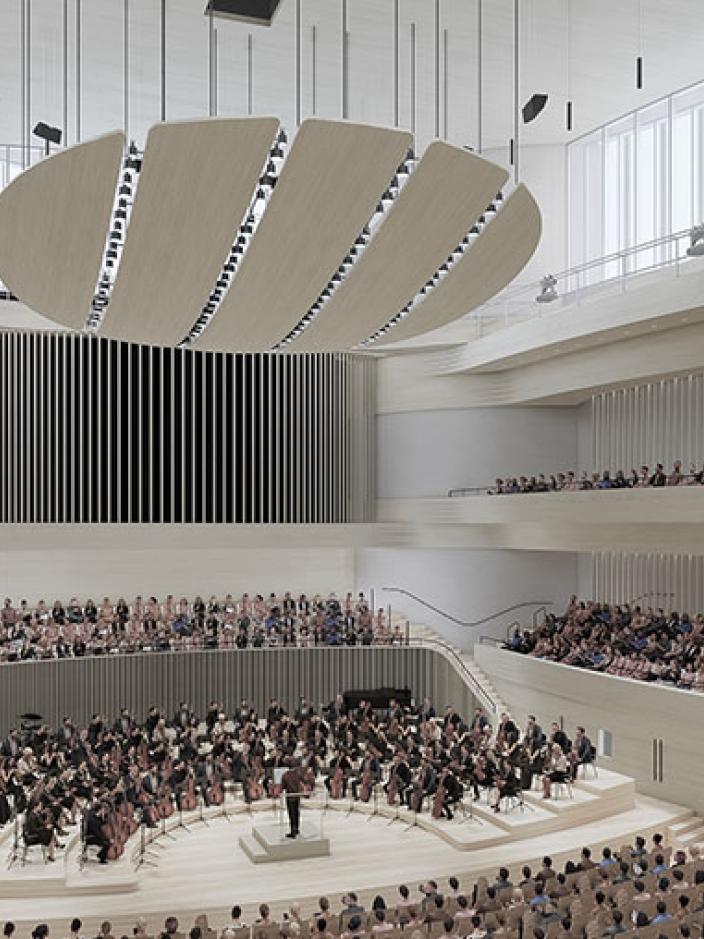The acoustics of Music Hall Fuuga are designed by the top sound designers in the world. The hall’s design is based on the latest research.
Acoustics is a key factor in the success of the Music Hall
The architecture and the acoustic design of the Music Hall has attracted widespread interest from the start.
– The attention we receive is well deserved. Acoustics is a key factor in the success of the Music Hall. We at the Turku Philharmonic Orchestra are lucky to have such high quality experts designing our new home, says Nikke Isomöttönen, Director of the Turku Philharmonic Orchestra.
Featuring accomplished designers
The Akukon & Kahle Acoustics consortium is responsible for Fuuga's acoustics design. The design team selected by the alliance consists of the most experienced concert designers from Akukon in Finland and Kahle Acoustics in Belgium.
The main acousticians are Eckhard Kahle, one of the world's most renowned concert hall acousticians, whose list of references includes the Paris Philharmonic and Stavanger Concert Hall, and multi-purpose hall acoustics experts Sara Vehviläinen and Henrik Möller.
The project manager of the acoustic design is Perttu Laukkanen, who has experience in acoustic design of several performance spaces both in Finland and abroad, one of them being the Queen Elizabeth Hall in London. The City of Turku's expert is award-winning acoustics researcher, professor Tapio Lokki from Aalto University.
Several projects together
Fuuga is the fourth concert hall where Kahle Acoustics and Akukon work together. In addition, Fuuga makes exceptionally extensive use of the latest available research data produced by the research team led by Tapio Lokki.
– I can safely say that no concert hall acoustic design has ever been done so scientifically before, says Tapio Lokki.
Research on concert hall acoustics has been conducted in Finland for 15 years under the leadership of Lokki. The expertise of the Kahle group focuses on, for example, the space angle review developed by Yann Jurkiewicz. It is capable of simulating the orientation of sound energy on different surfaces. Acoustic modelling, on the other hand, enables the calculation of room acoustic parameters and ensures the properties of the reverberation.
Text continues after image

Music surrounds the audience in a great hall
The acoustic design of concert halls is largely based on simulations. 3D models simulate the movement of sound: how sound moves and is reflected from different surfaces.
– We look at what part of the sound is directed at the audience, reflective surfaces, attenuated surfaces and what comes back as reverberation, says Lokki.
In Fuuga, the curvatures of the hall surfaces are optimised to the nearest millimetre.
– For example, the angles of the undersides of balconies play a role in ensuring that sound is distributed correctly. Even a variation of one degree has an effect. That's why, even during the construction phase, we need to pay attention to ensuring that all requirements are met, he continues.
According to Lokki, the aim is for the music to surround the audience. The audio experience should be the same no matter where the audience is sitting,” he says.
– Fuuga is looking for experience in which the hall supports orchestra play and is really expressive and emotional. I am feeling confident. Whether Fuuga will be a world-famous hall in terms of acoustics or a very good one, we'll find out when the building is finished, he concludes jovially.
The new Music Hall will be completed in 2026. The music hall will be built employing an alliance model, which includes the City of Turku and Hartela, as well as PES-Architects, WSP Finland and, as subcontractors, Laidun-design and the Akukon & Kahle Acoustics consortium.
